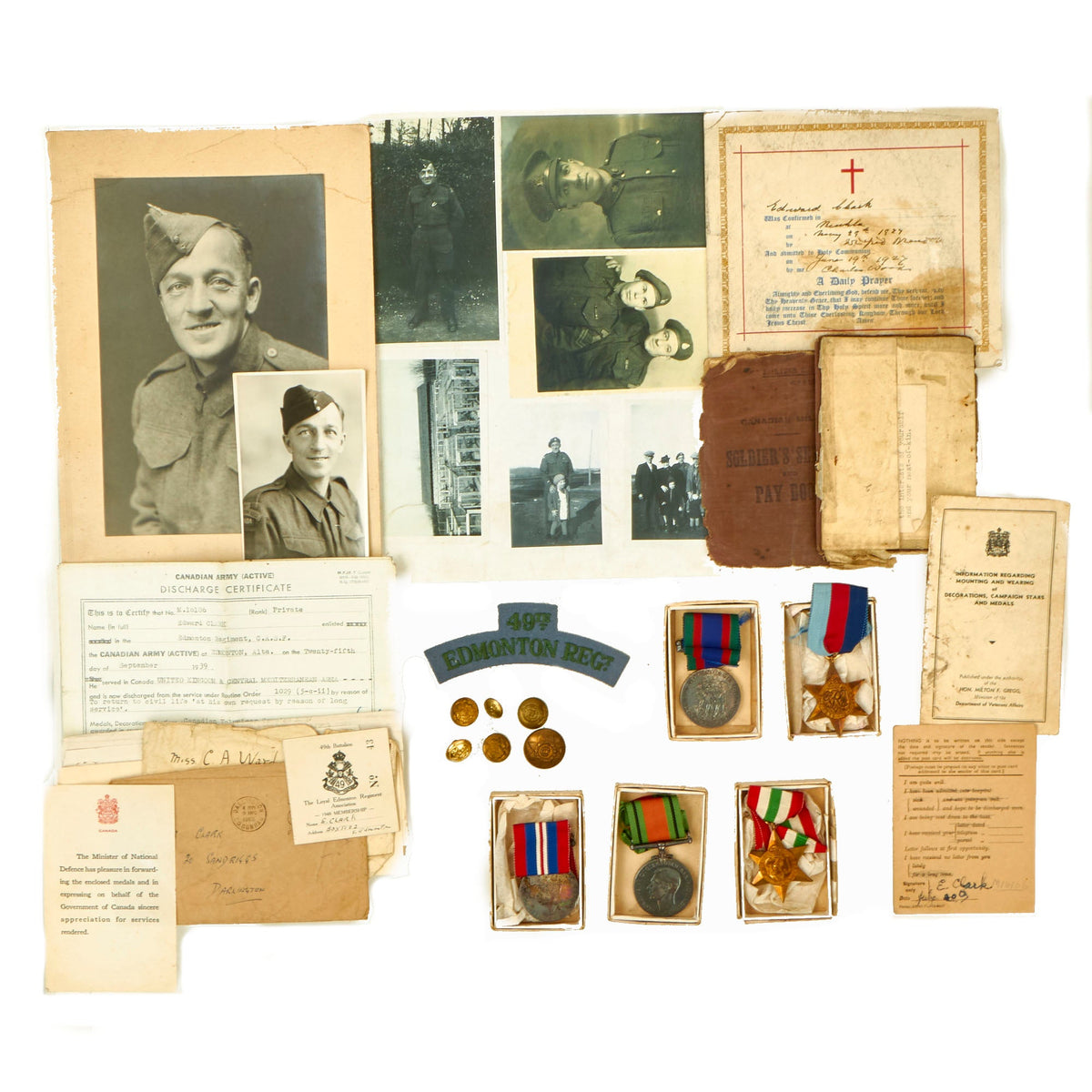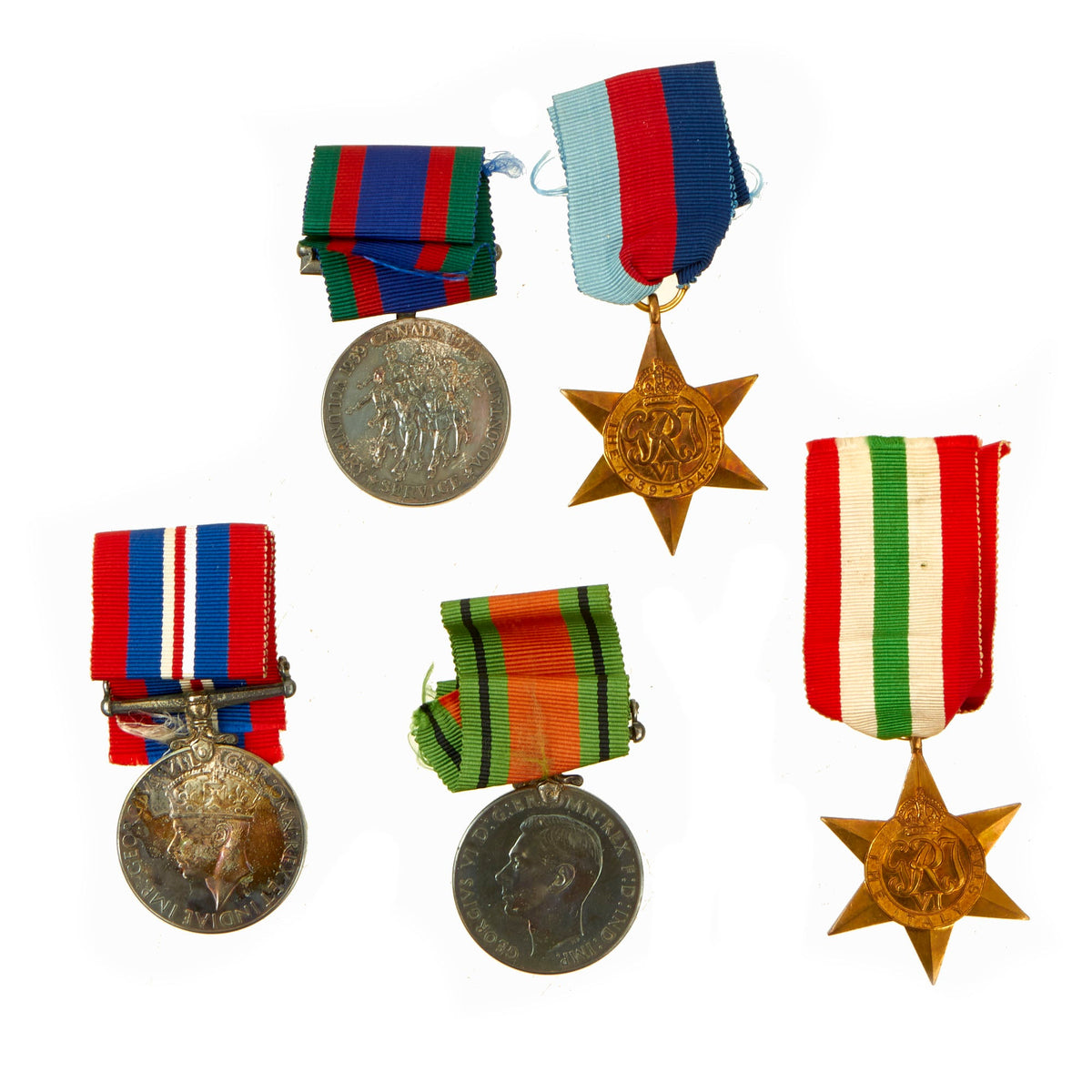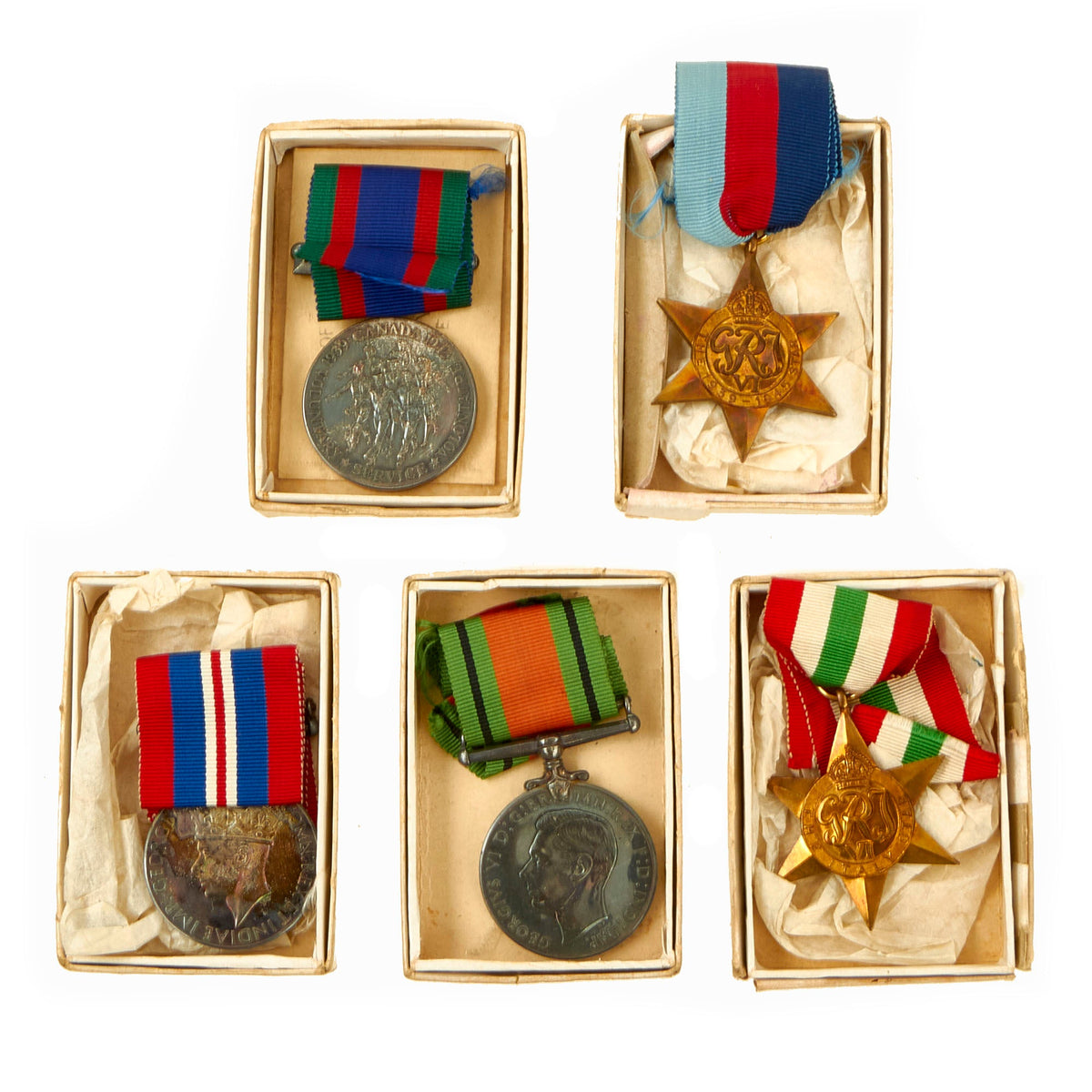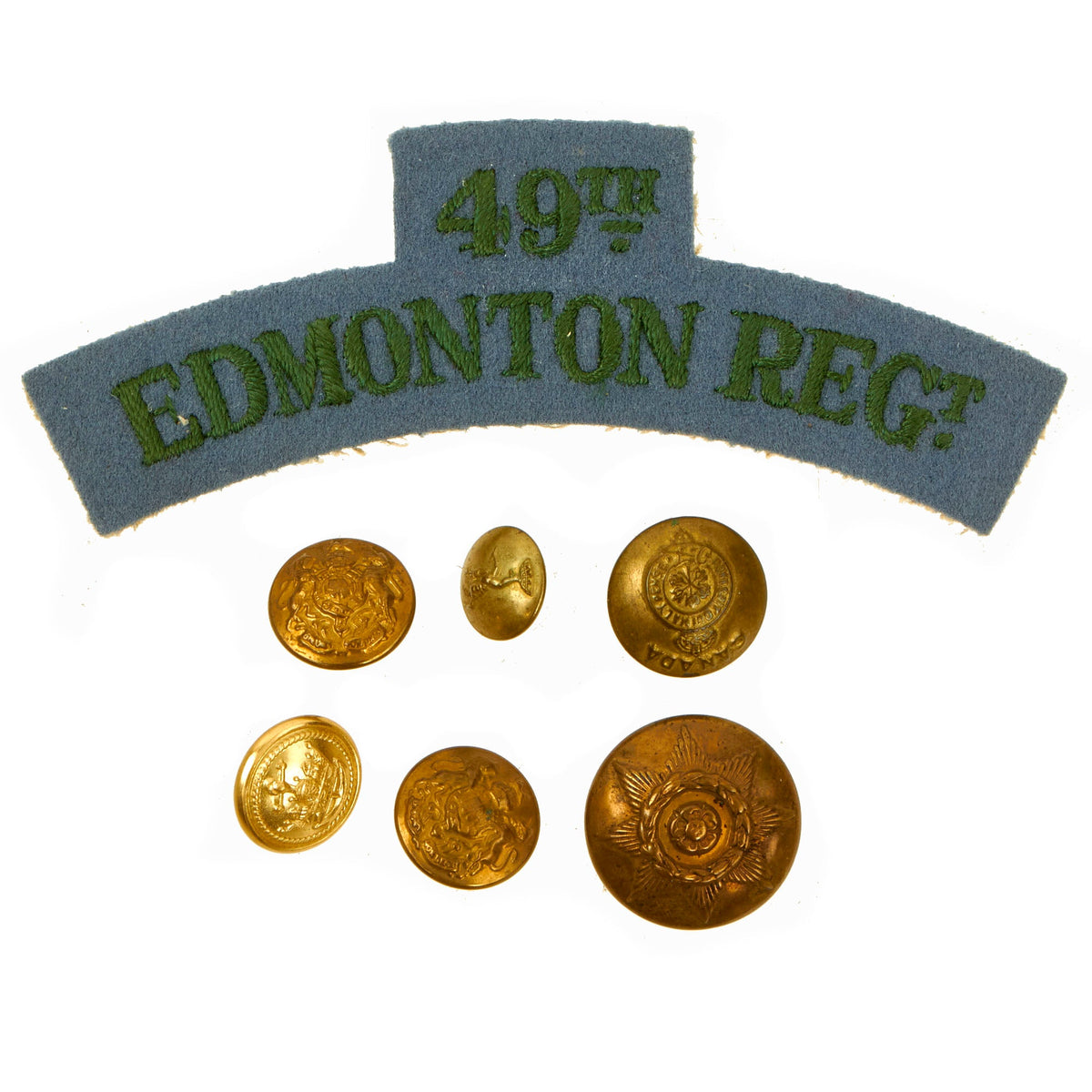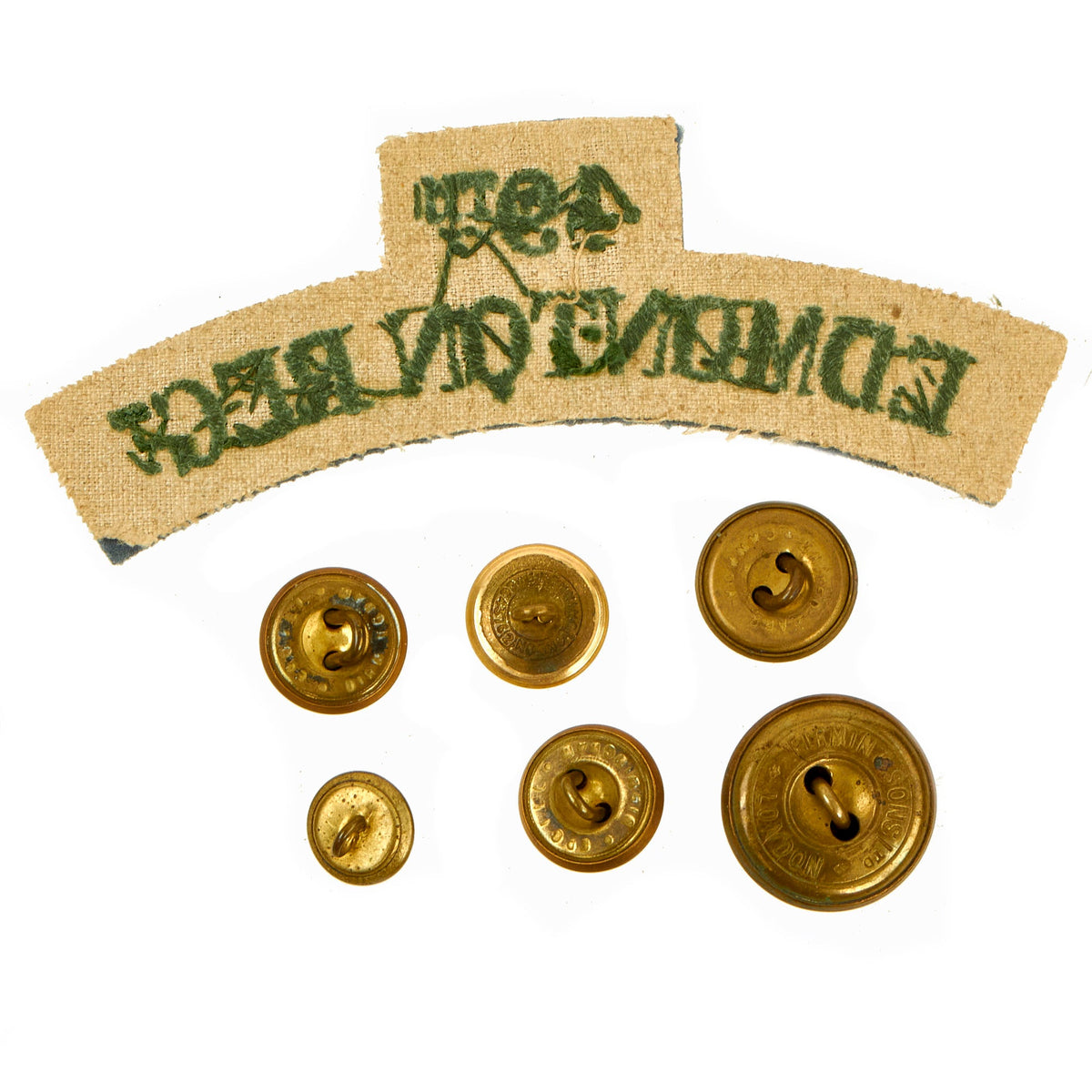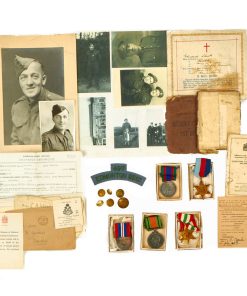Original Canada WWII Canadian Army Loyal Edmonton Regiment Medal, Insignia and Document Grouping For Private Edward Clark – 20 Plus Items Original Items
$ 395,00 $ 118,50
Original Items: Only One Group Available. This is a fantastic little Canadian grouping for Private Edwark Clark of the Loyal Edmonton Regiment. The Loyal Edmonton Regiment (4th Battalion, Princess Patricia’s Canadian Light Infantry), or L Edmn R, is a Primary Reserve infantry unit of the Canadian Armed Forces based in Edmonton, Alberta. The Loyal Edmonton Regiment is part of 3rd Canadian Division’s 41 Canadian Brigade Group. They are colloquially known as “The Loyal Eddies”.
The regiment mobilized The Edmonton Regiment, CASF for active service on 1 September 1939. It was redesignated as the 1st Battalion, The Edmonton Regiment, CASF on 7 November 1940; and as the 1st Battalion, The Loyal Edmonton Regiment on 7 July 1943. On 22 December 1939, it embarked for Great Britain. “D” Company participated in the expedition to the Norwegian island of Spitzbergen on 25 August 1941, and the battalion landed in Sicily on 10 July and Italy on 3 September 1943, as part of the 2nd Infantry Brigade, 1st Canadian Infantry Division. The unit landed in France on 15 March 1945 as part of Operation Goldflake, on its way to the Northwest Europe theatre of operations, in which it fought until the end of the war. The overseas battalion disbanded on 15 October 1945.
Leonforte, July 1943. According to Mitcham and von Stauffenberg in The Battle of Sicily, The Loyal Edmonton Regiment allegedly killed captured German prisoners. On 1 June 1945, a second Active Force component of the regiment was mobilized for service in the Pacific theatre of operations, as under the 3rd Canadian Infantry Battalion (The Loyal Edmonton Regiment), CASF. The battalion disbanded on 1 November 1945.
The Items In This Grouping:
– War Medal 1939–1945: The War Medal 1939–1945 is a campaign medal which was instituted by the United Kingdom on 16 August 1945, for award to citizens of the British Commonwealth who had served full-time in the Armed Forces or the Merchant Navy for at least 28 days between 3 September 1939 and 2 September 1945.
The War Medal 1939–1945 is a disc, 36 millimeters (1.42 inches) in diameter. The non-swivelling straight bar suspender is attached to the medal with a single-toe claw mount and a pin through the upper edge of the medal. The British issue medals were struck in cupro-nickel, while those awarded in Canada (about 700,000)[6] were struck in silver. The medal is sometimes incorrectly referred to as the “Victory Medal” for the Second World War.
Obverse
The obverse shows the crowned effigy of King George VI, facing left and signed “PM”, the initials of designer Percy Metcalfe, below the truncated neck of the effigy. Around the perimeter is the legend “GEORGIVS VI D:G:BR:OMN:REX ET INDIAE IMP:”.
Reverse
The reverse shows a lion standing wanton on the body of a double-headed dragon. The dragon’s heads are those of an eagle and a dragon, to signify the principal occidental and oriental enemies during the Second World War. At the top, just to the right of center are the years “1939” and “1945” in two lines. The initials “ECRP” of designer Edward Carter Preston are near the rim at the nine o’clock position. Preston also designed the bronze memorial plaque which was presented to the next-of-kin of British servicemen and women who fell during the First World War.
– Canadian Volunteer Service Medal: The Canadian Volunteer Service Medal is granted to persons of any rank in the Naval, Military or Air Forces of Canada who voluntarily served on Active Service from September 3, 1939, to March 1, 1947. The medal was established on October 22, 1943.
The medal is circular, made of silver (.925 fine silver), 1.42 inches (36 mm) in diameter. The obverse depicts seven marching figures, representing men and women of the army, air force, navy and nursing service. Around the rim is the inscription 1939 CANADA 1945 VOLUNTARY SERVICE VOLONTAIRE. The seven marching figures were based on real people taken from the National Defence photographs. The reverse shows the coat of arms of Canada. Medals were issued unnamed.
The medal is linked to a straight suspender by a small ring passing through a small fixed ring at the top of the medal. It is suspended from a 1.25 inches (32 mm) wide with a royal blue center 0.5 inches (13 mm) flanked by two equal stripes of scarlet and dark green, the dark green being on the edges. The ribbon was issued during the war; the medal after the war.
The medal was designed by the war artist Major Charles Comfort.
Defence Medal (United Kingdom): The Defence Medal is a campaign medal instituted by the United Kingdom in May 1945, to be awarded to citizens of the British Commonwealth for both non-operational military and certain types of civilian war service during the Second World War.
The Defence Medal is a disk, 36 millimeters (1.42 inches) in diameter. The non-swivelling straight bar suspender is attached to the medal with a single-toe claw mount and a pin through the upper edge of the medal. The British issue medals were struck in cupro-nickel, while those awarded in Canada were struck in silver.
Obverse
The obverse, designed by Humphrey Paget, shows the bareheaded effigy of King George VI, facing left. Around the perimeter is the legend “GEORGIVS VI D:G:BR:OMN:REX F:D:IND:IMP.” (George 6th, by the grace of God, King of all the Britains, Defender of the Faith, Emperor of India).
Reverse
The reverse, designed by Harold Parker, shows the Royal Crown resting on an oak sapling, flanked by a lion and a lioness above stylised waves. At the top left is the year “1939” and at the top right the year “1945”. The exergue has the words “THE DEFENCE MEDAL” in two lines.
– Italy Star: The Italy Star is a military campaign medal, instituted by the United Kingdom in May 1945 for award to British Commonwealth forces who served in the Italian Campaign from 1943 to 1945, during the Second World War.
The set of nine campaign stars was designed by the Royal Mint engravers. The stars all have a ring suspender which passes through an eyelet formed above the uppermost point of the star. They are six–pointed stars, struck in yellow copper zinc alloy to fit into a 44 millimeters diameter circle, with a maximum width of 38 millimeters and 50 millimeters high from the bottom point of the star to the top of the eyelet.
Obverse
The obverse has a central design of the Royal Cypher “GRI VI”, surmounted by a crown. A circlet, the top of which is covered by the crown, surrounds the cypher and is inscribed “THE ITALY STAR”.
1939–1945 Star: The 1939–1945 Star is a military campaign medal instituted by the United Kingdom on 8 July 1943 for award to British and Commonwealth forces for service in the Second World War. Two clasps were instituted to be worn on the medal ribbon, Battle of Britain and Bomber Command.
The set of nine campaign stars was designed by the Royal Mint engravers. The stars all have a ring suspender which passes through an eyelet formed above the uppermost point of the star. They are six–pointed stars, struck in yellow copper zinc alloy to fit into a 44 millimeters diameter circle, with a maximum width of 38 millimeters and 50 millimeters high from the bottom point of the star to the top of the eyelet.
Obverse
The obverse has a central design of the Royal Cypher “GRI VI”, surmounted by a crown. A circlet, the top of which is covered by the crown, surrounds the cypher and is inscribed “THE 1939–1945 STAR”.
– Canadian Militia Soldiers Service and Pay Book: The book is still mostly legible but the pages are detached and both covers are no longer attached.
– x6 Various Uniform Buttons
– Packet of 3 Medal Replacement Ribbons
– Unissued 49th Edmonton Regiment Sleeve Patch
– x5 Various Paper Items: They include a guide on how to wear military decorations, a note from the Minister of National Defence, 2 post war dated envelopes and a first confirmation/communion card from the church.
– 1943 Dated Field Service Postcard
– 1948 The Loyal Edmonton Regiment Association Card
– Canadian Army (Active) Discharge Certificate: States that Clark was in the Edmonton Regiment, C.A.S.F. and enlisted on September 25, 1939 and was discharged as a Private on June 29, 1945.
– 3”x5” Portrait of Clark
– “Collage” of 6 Pictures that were photocopied and labeled on the reverse.
– 5 ¼” x 8 ¼” Portrait of Clark
A wonderful grouping that comes more than ready for further research and display.
Fast Shipping with Professional Packaging
Thanks to our longstanding association with UPS FedEx DHL, and other major international carriers, we are able to provide a range of shipping options. Our warehouse staff is expertly trained and will wrap your products according to our exact and precise specifications. Prior to shipping, your goods will be thoroughly examined and securely secured. We ship to thousands clients each day across multiple countries. This shows how we're dedicated to be the largest retailer on the internet. Warehouses and distribution centres can be located throughout Europe as well as the USA.
Note: Orders with more than one item will be assigned a processing date depending on the item.
Before shipping before shipping, we'll conduct a thorough inspection of the items you have ordered. Today, the majority of orders will be delivered within 48 hours. The delivery time will be between 3-7 days.
Returns
The stock is dynamic and we cannot completely manage it because multiple stakeholders are involved, including our factory and warehouse. So the actual stock may alter at any time. It's possible that you may not receive your order once the order has been made.
Our policy is valid for a period of 30 days. If you don't receive the product within 30 days, we are not able to issue a refund or an exchange.
You can only return an item if it is unused and in the same state as the day you received it. You must have the item in its original packaging.
Related products
Uncategorized
Uncategorized
Uncategorized
Uncategorized
Australian WWII Owen MK1 Machine Carbine SMG Custom Fabricated Replica with Sling Original Items
Uncategorized
Uncategorized
Uncategorized
Band of Brothers ORIGINAL GERMAN WWII Le. F.H. 18 10.5cm ARTILLERY PIECE Original Items
Uncategorized
Uncategorized
Uncategorized
Uncategorized
Uncategorized
Uncategorized
Uncategorized
Uncategorized
Uncategorized
Uncategorized
